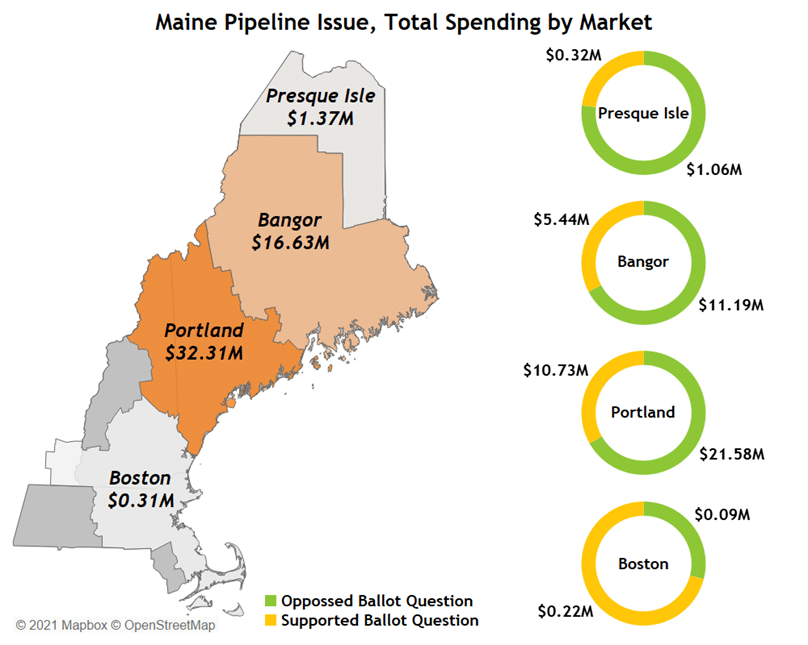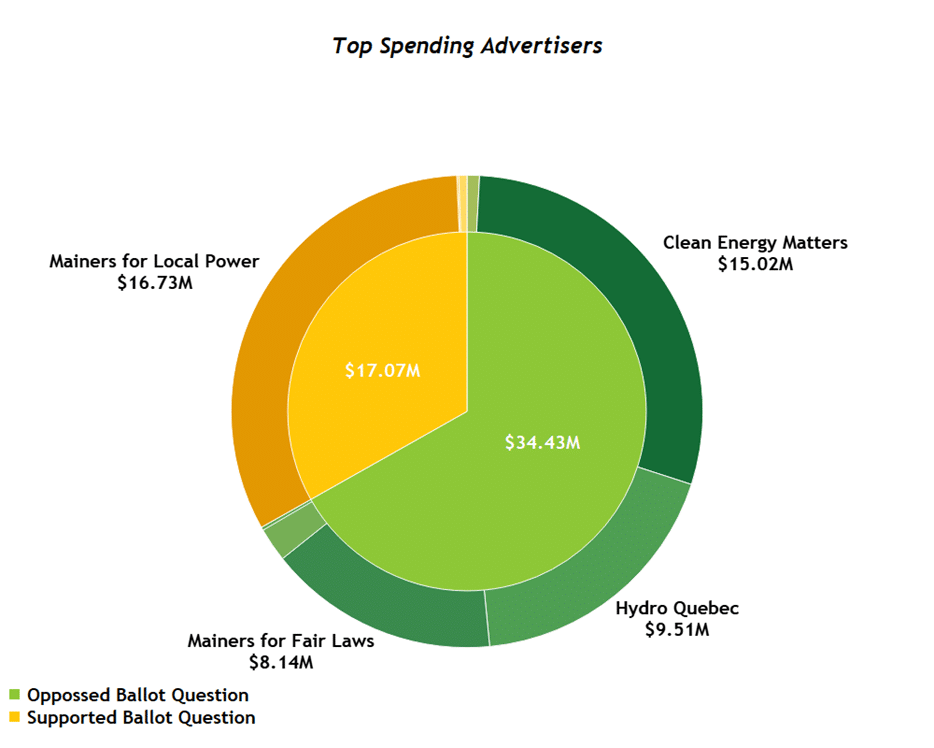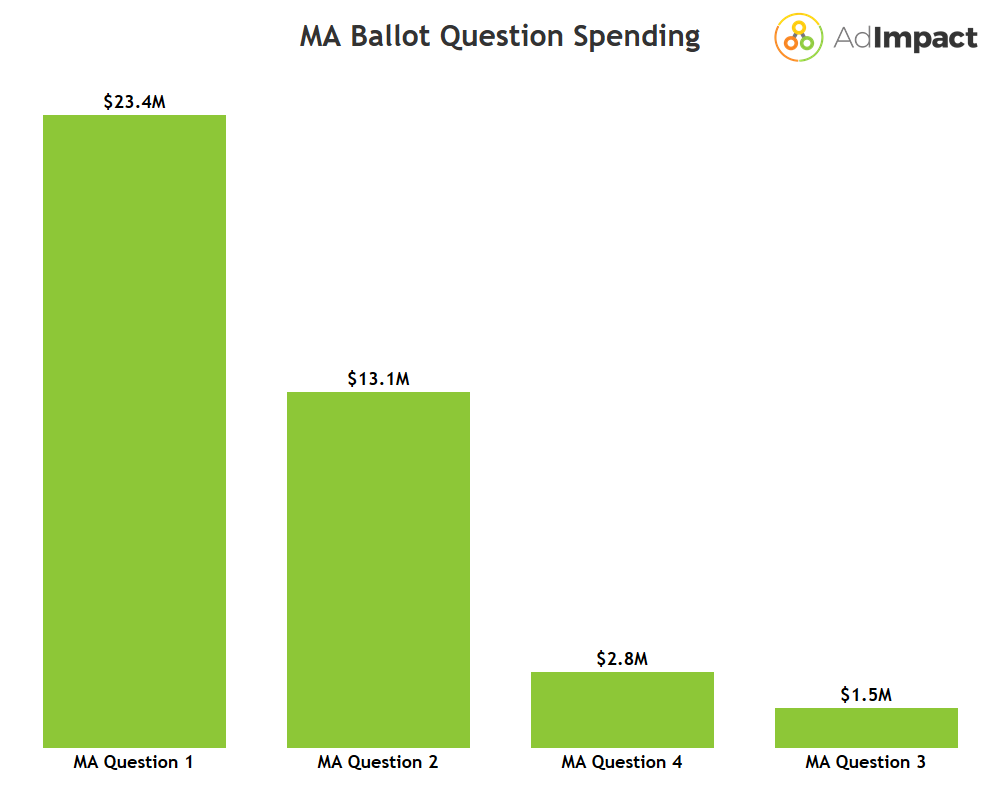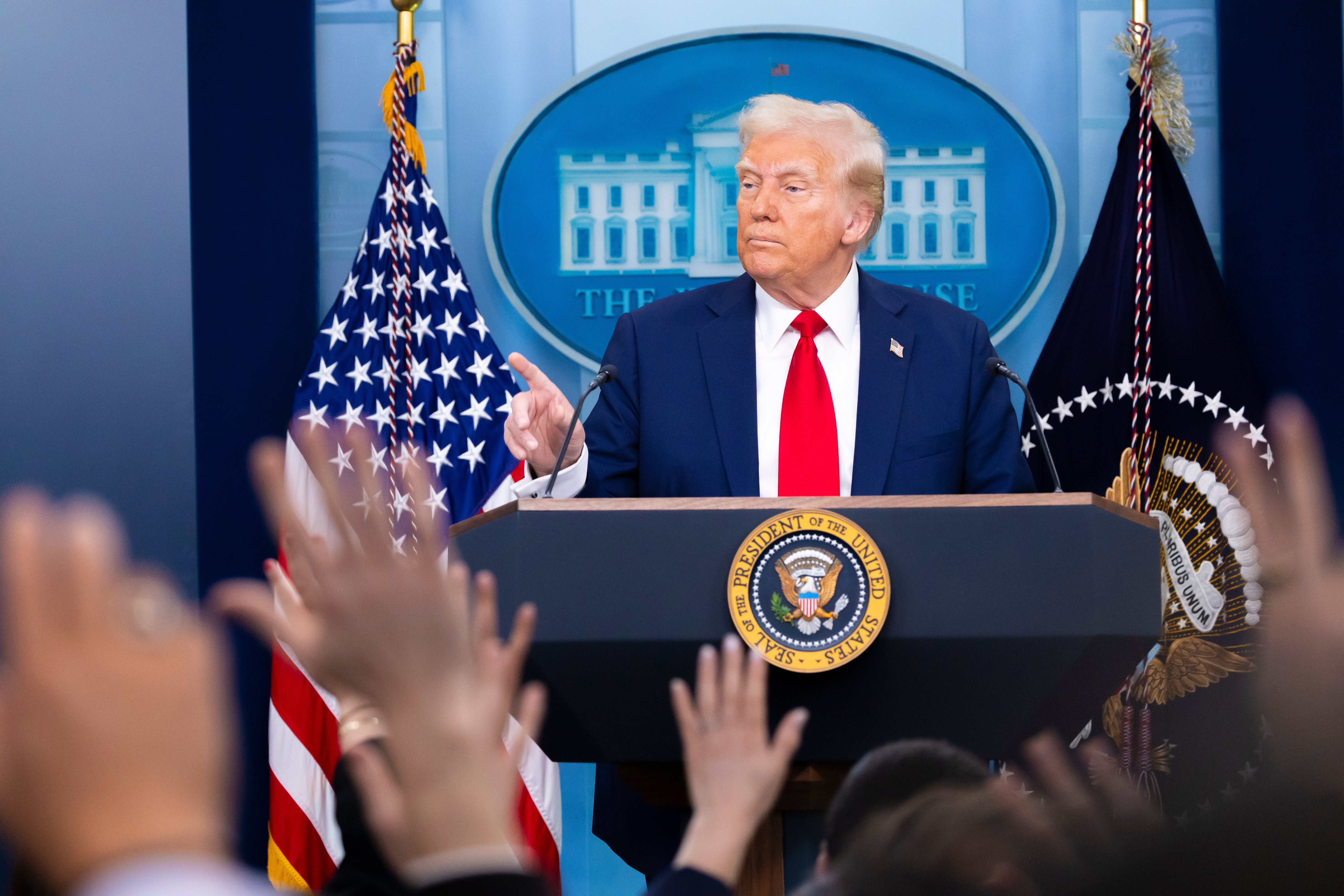Written by Ethan Mort
While all eyes this election day are on Congressional elections to see which party will hold more federal power, there are many equally as contested ballot initiatives across various states that are racking up plenty of advertising spending this election cycle as well. AdImpact has seen more spending in 2022 on individual state’s issues and ballot initiative spending than any other year on record. So far, we have seen $894 million spent on these issues and will breakdown where this spending has occurred in this advertising spending analysis of the behind the scenes side of political ad spending.

Ballot Initiatives Across the States
This election cycle many topical issues will be decided directly by voters across their states. The issue of abortion was on the ballot in Kansas last August, and come this November, it will also be on the ballot in California, Kentucky, Michigan, Montana and Vermont. In continuing a decade long trend—voters in Maryland, South Dakota, Missouri, Arkansas and North Dakota will get to vote on the legalization of Marijuana. Additionally, a vote to expand alcohol sales is up for debate by the voters in Colorado (across three different propositions!) and in Massachusetts. The issue of gambling has been an issue that has garnered a lot of attention on the airwaves this election cycle—especially for Californians. $271M was spent on California Proposition 27, which if passed would legalize online sports betting.

California has seen more spending on Prop issues this election cycle than 45 other states combined. The total spending towards California’s propositions have been $379M. All other US states excluding California, Massachusetts, Colorado and Nevada have a total state issue and ballot initiative spending of $94M combined. The closest state to California in terms of state issue and ballot initiative spending is Michigan at $44M, with $36M of that being from MI Prop 3. Behind Michigan is Massachusetts at $35M with 4 hotly contested ballot issues ranging from expanding alcohol licenses in the state to the creation of a progressive wealth tax. Colorado has seen $22M across multiple ballot issues ranging from decriminalizing specific psychedelics to allowing the sale of wine and beer in grocery stores. Then in Nevada, we’ve seen $13M total spent on issues. $12M of that is for NV Question 3, a ballot initiative that would see NV’s elections use ranked choice voting.

CA Prop Advertising Spending Breakdown
The ballot issue with the most spending recorded this election cycle by far is California’s Prop 27, Mobile Sports Betting and Revenue for Homelessness Issue, with $271 million spent on this issue. The second most expensive issue is another California proposition—CA Prop 26, Sports Betting on American Indian Lands Issue, which has a total of $45 million spent on ads targeting it. Interestingly, the top four ballot issues in terms of spending are all California Proposition Issues. The only non-Californian ballot initiative in the top five list, is MI Proposition 3, a proposition that—if passed would enshrine the individual right to reproductive freedom in Michigan.
Of the $271M spent on CA Prop 27, $150M has been spent in opposition, and $121M has been spent in support for this issue. Yes on 27, Californians for Solutions to Homelessness and Mental Health Support, who was the only advertiser group in support of Prop 27 has spent the most. In opposition was Californians for Tribal Sovereignty and Safe Gaming with $90M spent, and then Coalition for Safe Responsible Gaming, who spent $58M in opposition to Prop 27 and in support of Prop 26.
Yes on 27 dropped an incredible amount of money flooding the airwaves week by week, with it peaking in late Summer with $15.2M on the week of 8/21 then $19.7M the week of 9/4. However, their weekly spends dropped to $1-2M each week, to below $500K in the last two weeks leading up to the election.

In addition to CA Prop 27, there are three other Prop issues in the state that have garnered their fair share of spending are Prop 26, 30 and 29. California Prop 26, also deals with gambling—if passed it would allow federally recognized Native American tribes to expand their gambling operations to allow for sports betting as well as roulette and dice games at their casinos. Californians are looking as if they will reject both gambling propositions, 26 and 27, with a recent poll done by the Public Policy Institute of California finding Prop 26 losing 57-34% and Prop 27 losing 67% to 26%.

California Prop 30 is seeking to increase the tax on all personal income above $2M and to dedicate the revenue gained from it to zero emission vehicles and wildfire suppression and prevention programs We have seen $30.5M spent in support of the proposition, all from the group “Yes on 30”. $12.7M has been spent in opposition to Prop 30, done by the group “No on 30” Then there’s California Prop 29, which is seeking to change how Dialysis clinics operate within California. We’ve seen a total of $54M spent on Prop 29, all of that $54M has been spent in opposition to the prop.

Issue Advertising Spending Analysis: Michigan and Massachusetts
Moving eastwards, Michigan is another state like Kansas putting the issue of abortion rights directly to the voters. Michigan Proposition 3 is aiming to amend the state constitution to establish a new individual right to reproductive freedom. Despite the “No” camp outspending the “Yes” camp $24.8M vs $22.6M, the “Yes” side has been found leading 9-10 points in WDIV and CNN’s recent polls. Despite a total amount of $47M being spent on this election—there are only two advertisers spending. The Pro-No advertiser, Citizens to Support Michigan’s Children and Women has spent $24.8M while Reproductive Freedom for All has spent $22.6M

Additionally, Michigan’s Proposition 1 is seeking to amend the Michigan constitution to change state officers and legislators’ term limits to 12 total years and to require elected state legislative and executive officials to file annual financial disclosure reports. . Prop 1 has only seen $700K spent on ads, as it is an uncompetitive race as a WDIV poll has found “Yes” leads “No” 71% to 26%. Then there is Michigan Proposition 2, which would change voting rights in various ways. Prop 2 has seen $7.5M spent on ads in favor of it, with no opposition spending. $7M has been spent by a group called Promote the Vote and the remaining $500k has come from a group called Protect Michigan Voter ID. WDIV has also found a healthy lead for Prop 2 with 64% for yes and 33% for no.

Going even further east now, Massachusetts voters will face a lengthy ballot on Tuesday as they will have four ballot propositions to decide on. The most expensive issue in Massachusetts this year, MA Question #1- Tax on Income Above $1 Million for Education and Transportation. If passed, this would amend the state constitution to create an additional 4% tax for income over $1M and dedicate the revenue to education and transportation services. We have seen a total of $23M spent on Question 1, making it the second most expensive ballot question in Massachusetts’ history, only behind Massachusetts’ Question 1, Right to Repair in 2020 with a total of $36M. We have seen various advertisers spending on Question 1, but the two biggest ones have been the Fair Share Ballot Initiative Committee—which has spent $14M in favor of the question, and The Coalition to Stop the Tax Hike Amendment—which has spent $8M against the amendment. The Fair Share Ballot Initiative Committee has released ads describing Question 1 as being a progressive wealth tax on the super-rich that wouldn’t impact small businesses, while Stop the Tax Hike Amendment has released ads arguing the opposite—that if passed, Question 1 would unfairly tax sales of homes. A poll from the Boston Globe found the “Yes” camp leading 58% to 37%
Massachusetts Question 2, Medical Loss Ratios for Dental Insurance Plans is aiming to “require dental insurance carriers to meet a medical loss ratio of 83% and require the insurer to refund the excess premium to its covered individuals and covered groups”. There has been a total of $13M tracked for Question 2, $11M in support, and $2M against. A recent UMass Amherst/WCVB poll found “Yes” in the lead with 68% and “No” with 20%
Finally, there’s Massachusetts Question 4, which is a confirmation ballot question that is aiming to uphold Massachusetts’ recently passed House Bill 4805, which allowed individuals who cannot verify citizenship or immigration to obtain a driver’s license. We have seen $2.7M spent on this race with, the only advertiser spending being Safer Roads for Vote Yes for Work and Family Mobility in support of the question. A recent poll done by UMass Amherst/WCVB found 51% in favor of Question 4 and 39% in opposition.

Ballot initiatives, as they are so state specific do not get the same level of national attention such as Congressional elections, but through this advertising spending analysis it is quite clear that they should not be ignored from the conversation in regards to total advertising dollars. For this election cycle, ballot initiative and other issue group spending have accounted for almost $1B of the expected $9.7B spent on the 2022 election cycle this year.









